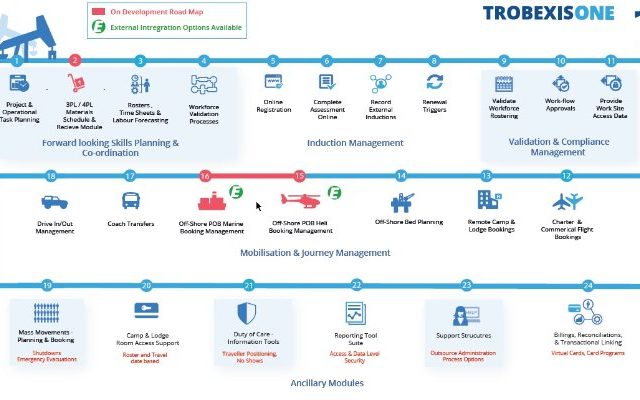During the course of 2015 and on into 16 I have been studying, researching as well as working. My study, research has been on various topics from IoT, Sustainability, Environment, Food Security, Complex Decision making, Supply Chain Management, Cyber Security, In memory Computing, Statistics to name but a few(FutureLearn). Work wise I have been a Consultant for Enterprises Solutions(Trobexis), Enterprise Asset Management, Enterprise Content Management (OpenText) in a variety of Industries, which include, Oil & Gas, Utilities, Construction, Maintenance even Banking. Here is the thing though, what do all these study, research and work all have in common? Simple BIG DATA!!!! That’s getting bigger everyday.
If you want to be successful with big data, you need to begin by thinking about solving problems in new ways. Many of the previous limitations placed on problem-solving techniques were due to lack of data, limitations on storage or computing power, or high costs. The technology of big data is shattering some of the old concepts of what can’t be done and opening new possibilities for innovation across many industries (SAP S/4 HANA.)
The new reality is that an enormous amount of data is generated every day that may have some relevance to your business, if you can only tap into it. Most likely, you have invested lots of resources to manage and analyse the structured data that you need to understand your customers, manage your operations, and meet your financial obligations. However, today you find huge growth in a very different type of data. The type of information you get from social media, news or stock market data feeds, and log files, and spatial data from sensors, medical-device data, or GPS data, is constantly in motion.
These newer sources of data can add new insight to some very challenging questions because of the immediacy of the knowledge. Streaming data, data in motion, provides a way to understand an event at the moment it occurs.
Working with TROBEXIS over the last 12 months we have built a model which has big data constantly in motion, which is both structured and unstructured, coming from a variety of sources, in a variety of formats. The data is constantly in motion and events occur when you least expect them, giving rise to exceptions and causing problems to occur in the best laid plans. Some of the questions that we have found ourselves asking are:
– Do we have the right people, with the right skills, in the right place, at the right time, in the right phase of the project, with the right materials, for the right service, at the right cost, in the right numbers, against the right contract, for the right client?
– What if we do this job, in a different phase of the project, using a different contractor, with a different set of numbers, an alternative process, with a higher cost?
– Are we buying the right materials, through the right channel, at the right cost using the right process?
Data in Motion – a real world view.
To complete a credit card transaction, finalise a stock market transaction, or send an e-mail, data needs to be transported from one location to another. Data is at rest when it is stored in a database in your data center or in the cloud. In contrast, data is in motion when it is in transit from one resting location to another.
Companies that must process large amounts of data in near real time to gain business insights are likely orchestrating data while it is in motion. You need data in motion if you must react quickly to the current state of the data.
Data in motion and large volumes of data go hand in hand. Many real-world examples of continuous streams of large volumes of data are in use today:
✓ Sensors are connected to highly sensitive production equipment to monitor performance and alert technicians of any deviations from expected performance. The recorded data is continuously in motion to ensure that technicians receive information about potential faults with enough lead time to make a correction to the equipment and avoid potential harm to plant or process.
✓ Telecommunications equipment is used to monitor large volumes of communications data to ensure that service levels meet customer expectations.
✓ Point-of-sale data is analysed as it is created to try to influence customer decision making. Data is processed and analysed at the point of engagement, maybe in combination with location data or social media data.
✓ Messages, including details about financial payments or stock trades, are constantly exchanged between financial organisations. To ensure the security of these messages, standard protocols such as Advanced Message Queuing Protocol (AMQP) or IBM’s MQSeries are often used. Both of these messaging approaches embed security services within their frameworks.
✓ Collecting information from sensors in a security-sensitive area so that an organisation can differentiate between the movement of a harmless animal and a car moving rapidly toward a facility.
✓ Medical devices can provide huge amounts of detailed data about different aspects of a patient’s condition and match those results against critical conditions or other abnormal indicators.
The value of streaming data
Data in motion, often in the form of streaming data, is becoming increasingly important to companies needing to make decisions when speed is a critical factor. If you need to react quickly to a situation, having the capability to analyse data in real time may mean the difference between either being able to react to change an outcome or to prevent a poor result. The challenge with streaming data is to extract useful information as it is created and transported before it comes to a resting location. Streaming data can be of great value to your business if you can take advantage of that data when it is created or when it arrives at your business.
You need to process and analyse the streaming data in real time so that you can react to the current state of the data while in motion and before it is stored. You need to have some knowledge of the context of this data and how it relates to historical performance. Also you need to be able to integrate this information with traditional operational data. The key issue to remember is that you need to have a clear understanding of the nature of that streaming data and what results you are looking for. For example, if your company is a manufacturer, it will be important to use the data coming from sensors to monitor the purity of chemicals being mixed in the production process. This is a concrete reason to leverage the streaming data. However, in other situations, it may be possible to capture a lot of data, but no overriding business requirement exists. In other words, just because you can stream data doesn’t mean that you always should.
How can you use data to change your business? In the following use cases, look at how organisations in several industries are finding ways to gain value from data in motion. In some situations, these companies are able to take data they already have and begin to use it more effectively. In other situations, they are collecting data that they were not able to collect before. Sometimes organisations can collect much more of the data that they had been only collecting snapshots of in the past. These organisations are using streaming data to improve outcomes for customers, patients, city residents, or perhaps for mankind. Businesses are using streaming data to influence customer decision making at the point of sale.
Use Cases
2015 became the age of the data driven organisation. Thanks to the rise of easier collection mechanisms and the ubiquity of available data sources, savvy organisations are now implementing data in new and novel ways that address real business issues. Here are just a few worth a mention: –
Objective: Operational Analysis; Efficiency Enhancement & Risk Elimination
Organization: Siemens
Article title: Using Big Data and Analytics to Design a Successful Future
Overview: Siemens Mobility Data Services division is capitalising on big data and analytics to ensure transportation around the globe is fast, reliable and more energy efficient. Innovation that includes predicting failures, ensuring a seamless supply chain for parts to reduce or eliminate downtime and use weather data to differentiate problems in the same train model in different regions.
URL: http://blogs.teradata.com/customers/siemens-using-big-data-analyticsdesign-successful-future/
Objective: Cost Analysis & Reduction, Operations Analysis, Risk Elimination
Organization: N/A
Article title: Could Big Data be the Solution to Clean Technology?
Overview: Big data analysis is extraordinarily useful and powerful in terms of identifying ways to reduce waste and improve processes. There is a massive amount of data available today that can be used to predict energy needs, improve energy production methods, build more energy-efficient structures, and even curb consumer energy consumption.
URL: http://blog.syncsort.com/2015/04/could-big-data-be-the-solution-to-cleantechnology/
Objective: Efficiency Enhancement, Market Sensing & Predictive Analysis
Organization: IBM
Article title: Big Data & Analytics adds to the power of Renewable Energy
Overview: Sophisticated weather forecasting and analytics matures renewable energy market
URL: http://www.ibmbigdatahub.com/infographic/big-data-analytics-adds-powerrenewable-energy
Objective: Cost Analysis & Reduction, Risk Elimination
Organization: N/A
Article title: Use Big Data to Survive Market Volatility
Overview: For every single well they own, executives in the oil and gas industry must know full lifecycle costs, from exploration to abandonment. Data is the foundation of this understanding; even at a basic level it requires looking at everything from geophysical exploration data to real-time production data to refining operations data to trading data, and more.
URL: http://data-informed.com/use-big-data-to-survive-market-volatility/
Objective: Operations Analysis; Revenue Generation / Customer Acquisition
Organization: Panjiva
Article title: The global import-export data you need to take your business across borders
Overview: From import-export trends, to the tally of cargos for individual shippers or consignees, right down to the details of each transaction – you are just clicks away from information you need to gain market insights
Objective: Risk Elimination
Organization: N/A
Article title: How advanced analytics are redefining banking
Overview: Innovators are using big data and analytics to sharpen risk assessment and drive revenue.
Objective: Efficiency Enhancement
Organization: Nutanix
Article title: The Impact of Big Data on the Data Supply Chain
Overview: The impact of big data on the data supply chain (DSC) has increased exponentially with the proliferation of mobile, social and conventional Web computing. This proliferation presents multiple opportunities in addition to technological challenges for big data service providers.
URL: http://linkis.com/flashglobal.com/86eXA
Objective: Market Sensing / Predictive Analysis
Organization: DHL
Article title: “Big Data in Logistics: A DHL perspective on how to move beyond the hype”
Overview: Big Data is a relatively untapped asset that companies can exploit once they adopt a shift of mindset and apply the right drilling techniques.
URL:http://www.dhl.com/content/dam/downloads/g0/about_us/innovation/CSI_Studie_BIG_DATA.pdf
Objective: Operations Analysis
Organization: N/A
Article title: Making Big Data Work: Supply Chain Management
Overview: The combination of large, fast-moving, and varied streams of big data and advanced tools and techniques such as geo analytics represents the next frontier of supply chain innovation. When they are guided by a clear understanding of the strategic priorities, market context, and competitive needs of a company, these approaches offer major new opportunities to enhance customer responsiveness, reduce inventory, lower costs, and improve agility.
Objective: Efficiency Enhancement
Organization: Transport for London
Article title: How Big Data And The Internet Of Things Improve Public Transport In London
Overview: Transport for London (TfL) oversees a network of buses, trains, taxis, roads, cycle paths, footpaths and even ferries which are used by millions every day. Running these vast networks, so integral to so many people’s lives in one of the world’s busiest cities, gives TfL access to huge amounts of data. This is collected through ticketing systems as well as sensors attached to vehicles and traffic signals, surveys and focus groups, and of course social media.
And one of my particular favourites being a lover of Starbucks……
Objective: New Product Creation
Organization: Starbuck’s
Article title: How Big Data Helps Chains Like Starbucks Pick Store Locations – An (Unsung) Key To Retail Success
Overview: The reality is that 94% of retail sales are still rung up in physical stores, and where merchants place those stores plays an outsized role in determining whether their chains fly or flop.
Article by channel:
Everything you need to know about Digital Transformation
The best articles, news and events direct to your inbox






